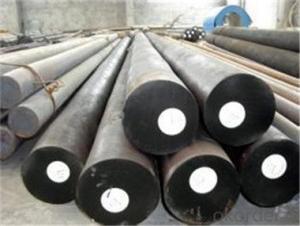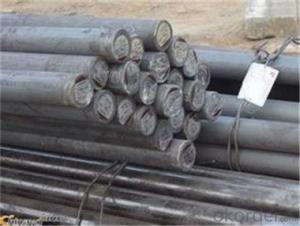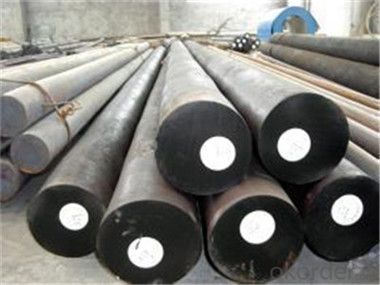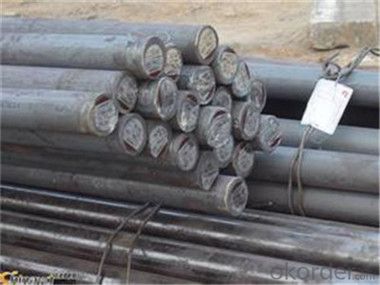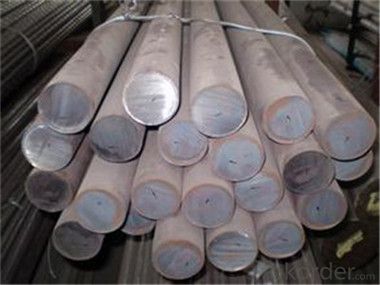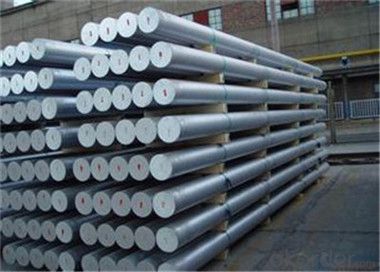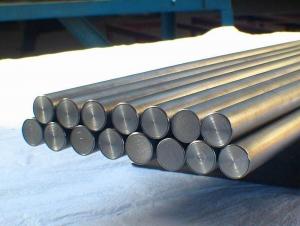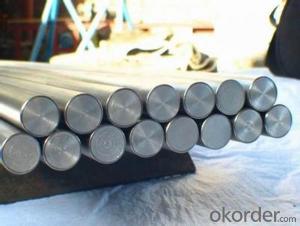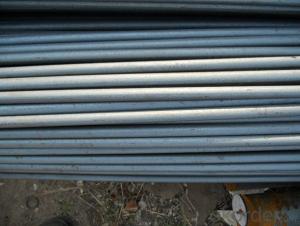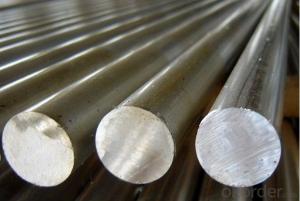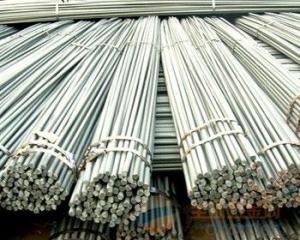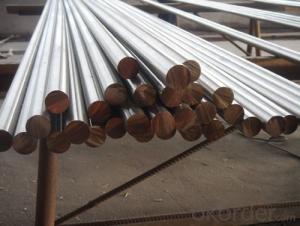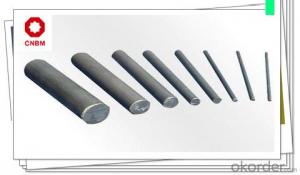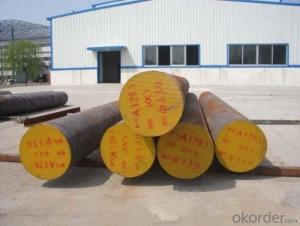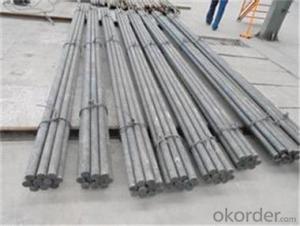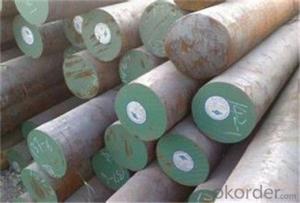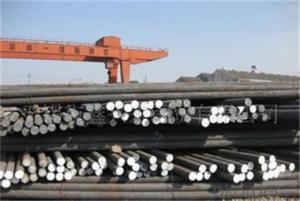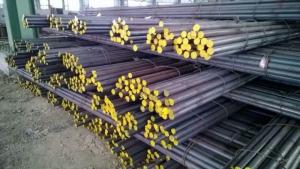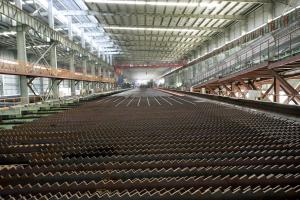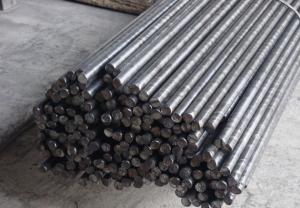Hot Rolled Carbon Steel Round Bar MS Bar -CNBM
- Loading Port:
- Tianjin
- Payment Terms:
- TT OR LC
- Min Order Qty:
- 88 m.t.
- Supply Capability:
- 2000000 m.t./month
OKorder Service Pledge
OKorder Financial Service
You Might Also Like
Description of steel round bar:
1. Commodity: Round steel bar
3. Technical: Hot rolling
2. Length: Min. 5.8meter, according to requirement.
3. Diameter: 16mm-250mm
5. Packing: In Bundle or according to your requirements.
Festures of steel round bar:
Description : Steel Bar/Stainless Steel Round Bar/Alloy Steel Round Bar/Carbon Steel Bar
Stainless Steel Bright Bar/Stainless Steel Peeled Bar/Stainless Steel Polishing Bar
Diamater:
Specifications of steel round bar:
Length: standard 6m,9m,12m, or as customers' requirement
Surface: Black, polished, grinded, ,Bright, Turn smooth(Peeled),Brush,Mill,Pickled
Process:Hot rolled,cold drawn,forged
Images of steel round bar:
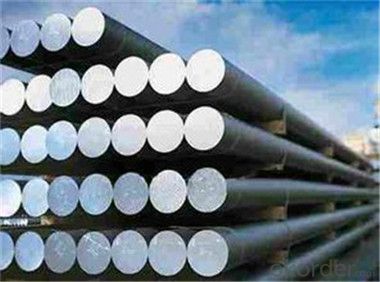
FAQ:
1. What is your main market?
We mainly export to Asia such as Japan,Korea,Thailand and North America and Middle East.
2. How long is the lead time?
Delivery time: 45 days after order confirmed.
3.Why do you choose to cooperate with us?
We have over10 years experience in this business so we are able to provide you the high quality products with the best price.
- Q: How do you store steel round bars to prevent damage?
- In order to store steel round bars and prevent damage, it is important to follow several crucial steps. Firstly, it is essential to keep the bars in a dry and well-ventilated area to avoid the buildup of moisture, which can lead to rusting. Additionally, moisture can cause the bars to become brittle and weaken over time. Next, it is recommended to store the round bars horizontally instead of vertically. This will prevent warping or bending caused by the weight of the bars pressing down on each other. If vertical storage is necessary, it is vital to use appropriate racks or supports that evenly distribute the weight. Furthermore, it is important to avoid stacking the bars too high, as excessive weight can cause deformation or collapse. If stacking cannot be avoided, sturdy supports should be used and the weight should be evenly distributed across the stack. Moreover, it is advisable to separate different sizes or types of steel round bars to prevent scratching or damage. This can be achieved by using separators or dividers to create distinct compartments for each type of bar. Lastly, regular inspection of the stored round bars for any signs of rust, corrosion, or damage is necessary. If any issues are detected, prompt measures should be taken to address them. This may involve applying rust inhibitors, cleaning the bars, or seeking assistance from professionals. By adhering to these storage guidelines, the steel round bars can be effectively protected from damage, ensuring their longevity and quality.
- Q: What are the advantages of using nickel-manganese alloy steel round bars?
- There are several advantages of using nickel-manganese alloy steel round bars. Firstly, these bars have excellent strength and toughness, making them suitable for applications that require high load-bearing capacity. Secondly, nickel-manganese alloy steel round bars exhibit good corrosion resistance, making them ideal for use in environments with high moisture or chemicals. Additionally, these bars offer good weldability, allowing for easy fabrication and assembly. Lastly, the inclusion of nickel and manganese in the alloy enhances the bars' heat resistance, making them suitable for applications involving high temperatures. Overall, the use of nickel-manganese alloy steel round bars provides a combination of strength, corrosion resistance, weldability, and heat resistance, making them a versatile choice for various industrial applications.
- Q: Can steel round bars be used for making rebar?
- Yes, steel round bars can be used for making rebar. In fact, many rebar manufacturers use steel round bars as a primary material for producing rebar due to their strength and durability.
- Q: Are steel round bars suitable for the production of springs?
- Yes, steel round bars are suitable for the production of springs. Steel is a commonly used material for springs due to its excellent strength and durability properties. The round shape of the bars allows for easy shaping and forming, making them ideal for spring manufacturing processes. Steel round bars can be easily machined and heat-treated to achieve the desired spring characteristics such as elasticity and resilience. Additionally, steel has a high tensile strength and can withstand heavy loads, making it suitable for applications that require strong and reliable springs.
- Q: What are the advantages of using nickel-chromium-manganese alloy steel round bars?
- There are several advantages of using nickel-chromium-manganese alloy steel round bars in various applications. Firstly, this type of alloy steel offers excellent strength and durability. The combination of nickel, chromium, and manganese enhances the overall strength of the steel, making it resistant to wear, impact, and deformation. This is particularly beneficial in industries such as construction, manufacturing, and automotive, where the round bars are commonly used for structural support and load-bearing purposes. Secondly, nickel-chromium-manganese alloy steel round bars exhibit excellent corrosion resistance. The presence of nickel and chromium in the alloy composition makes it highly resistant to rust and oxidation, even in harsh environments or exposure to corrosive substances. This property is crucial in applications where the round bars are exposed to moisture, chemicals, or high temperatures, such as marine environments or chemical processing plants. Additionally, this type of alloy steel offers good weldability and machinability. The combination of nickel, chromium, and manganese provides a balanced composition that allows for easy welding and machining operations. This makes it convenient for fabricators and manufacturers to work with the round bars, enabling them to create complex shapes or structures without compromising the material's integrity. Moreover, nickel-chromium-manganese alloy steel round bars have excellent heat resistance. The presence of nickel and chromium in the alloy composition enhances its ability to withstand high temperatures without losing its strength or shape. This property makes it suitable for applications that involve exposure to extreme heat, such as furnace components, heat exchangers, or high-temperature industrial processes. Lastly, the use of nickel-chromium-manganese alloy steel round bars often leads to cost savings in the long run. Due to their exceptional strength and durability, these round bars have a longer lifespan compared to other materials. This reduces the need for frequent replacements, resulting in lower maintenance costs and improved overall efficiency. In conclusion, the advantages of using nickel-chromium-manganese alloy steel round bars include excellent strength and durability, corrosion resistance, weldability, machinability, heat resistance, and long-term cost savings. These properties make them a preferred choice in various industries where high-performance materials are required.
- Q: Can steel round bars be used for making electrical system components?
- Certainly! Steel round bars have the potential to be utilized in the production of electrical system components. Steel, being a versatile material with a wide range of applications across different industries, including electrical engineering, offers the possibility of being used in specific sections of an electrical system. While materials such as copper are commonly preferred for electrical components due to their superior electrical conductivity, steel can still be employed for certain parts of the system. Structural components, supports, enclosures, or mounting brackets for electrical devices are examples of uses for steel round bars. Furthermore, steel's durability, strength, and resistance to corrosion make it an appropriate option for electrical system components that require a sturdy construction or protection against environmental factors. However, it is important to acknowledge that steel is not as efficient a conductor of electricity as materials like copper or aluminum, meaning it may not be suitable for components that necessitate high electrical conductivity.
- Q: How are steel round bars measured and specified?
- Steel round bars are measured and specified based on their diameter. The diameter of a round bar is typically measured in millimeters (mm) or inches (in). The measurement is taken across the widest point of the circular cross-section. In terms of specification, steel round bars are commonly specified by their diameter and length. For example, a specification for a steel round bar may be written as "25mm diameter x 3 meters length". This means that the bar has a diameter of 25mm and a length of 3 meters. Additionally, steel round bars may also be specified based on their tolerance, surface finish, and grade. Tolerance refers to the allowable deviation from the specified diameter. Surface finish refers to the quality of the bar's surface, which can range from rough to smooth. Grade refers to the quality and composition of the steel used to make the round bar, such as mild steel, carbon steel, or alloy steel. It is important to accurately measure and specify steel round bars to ensure that they meet the required dimensions and properties for a particular application.
- Q: What are the advantages of using nickel-aluminum alloy steel round bars?
- There are several advantages of using nickel-aluminum alloy steel round bars. Firstly, nickel-aluminum alloy steel round bars offer excellent corrosion resistance. This makes them suitable for applications in environments where the material is exposed to moisture, chemicals, or extreme temperatures. The corrosion resistance helps prolong the lifespan of the round bars and reduces the need for frequent maintenance or replacement. Secondly, nickel-aluminum alloy steel round bars exhibit high strength and toughness. This makes them ideal for use in structural applications that require a durable and reliable material. The high strength of these round bars enables them to withstand heavy loads and impacts without deforming or breaking, ensuring the structural integrity of the application. Additionally, nickel-aluminum alloy steel round bars have good heat resistance. They can withstand high temperatures without losing their mechanical properties, making them suitable for use in applications that involve heat or thermal cycling. This heat resistance also allows the round bars to maintain their shape and strength under extreme temperature variations. Moreover, nickel-aluminum alloy steel round bars have excellent machinability. They can be easily cut, drilled, and shaped into various forms, making them versatile for different applications. The machinability of these round bars reduces manufacturing time and costs, as well as enables customization to specific design requirements. Furthermore, nickel-aluminum alloy steel round bars have good weldability. They can be easily welded or joined to other materials without compromising their mechanical properties. This allows for the construction of complex structures or assemblies that require different materials to be joined together. Overall, the advantages of using nickel-aluminum alloy steel round bars include corrosion resistance, high strength and toughness, heat resistance, good machinability, and weldability. These properties make them a reliable and versatile choice for a wide range of applications in various industries such as aerospace, automotive, construction, and marine.
- Q: Can steel round bars be used in high-temperature environments?
- Yes, steel round bars can be used in high-temperature environments. However, the specific type of steel and its composition need to be carefully chosen to ensure it has the necessary heat resistance properties, such as high melting point and good strength retention at elevated temperatures.
- Q: How are steel round bars used in the oil and gas industry?
- The oil and gas industry extensively utilizes steel round bars for a multitude of purposes. Primarily, these bars are crucial in drilling operations as they are employed in the production of drill bits and drill collars, which are essential components of drilling equipment. Given the substantial levels of stress and wear experienced during drilling, steel round bars provide the necessary strength and durability to withstand such conditions. Moreover, steel round bars are utilized in the construction of oil and gas pipelines. These pipelines are responsible for the long-distance transportation of crude oil, natural gas, and other petroleum products. By utilizing steel round bars in the manufacturing of these pipes, their strength and resistance to corrosion are guaranteed, enabling them to endure the harsh operating conditions. Additionally, steel round bars find application in the construction of oil and gas storage tanks and pressure vessels. These containers are employed for the storage and transportation of petroleum products and gases under high pressure. Steel round bars ensure the required structural integrity and strength, thereby ensuring the safe storage and transportation of these substances. Furthermore, steel round bars are involved in the fabrication of various other equipment that is utilized in the oil and gas industry, including valves, fittings, pumps, and compressors. These components are pivotal for the efficient and safe operation of oil and gas production facilities. To summarize, steel round bars play a vital role in the oil and gas industry by being used in drilling operations, pipeline construction, storage tank fabrication, and the manufacturing of various equipment. Their exceptional strength, durability, and resistance to corrosion make them an ideal choice for these demanding applications, ultimately guaranteeing the efficient and safe extraction, transportation, and storage of oil and gas.
Send your message to us
Hot Rolled Carbon Steel Round Bar MS Bar -CNBM
- Loading Port:
- Tianjin
- Payment Terms:
- TT OR LC
- Min Order Qty:
- 88 m.t.
- Supply Capability:
- 2000000 m.t./month
OKorder Service Pledge
OKorder Financial Service
Similar products
Hot products
Hot Searches
